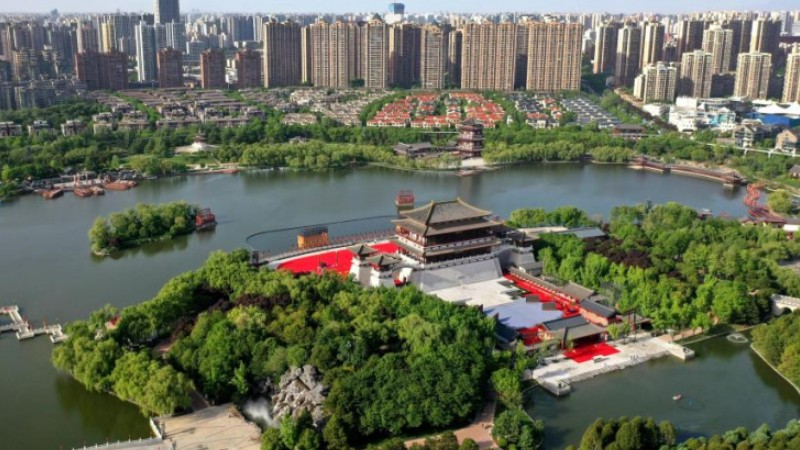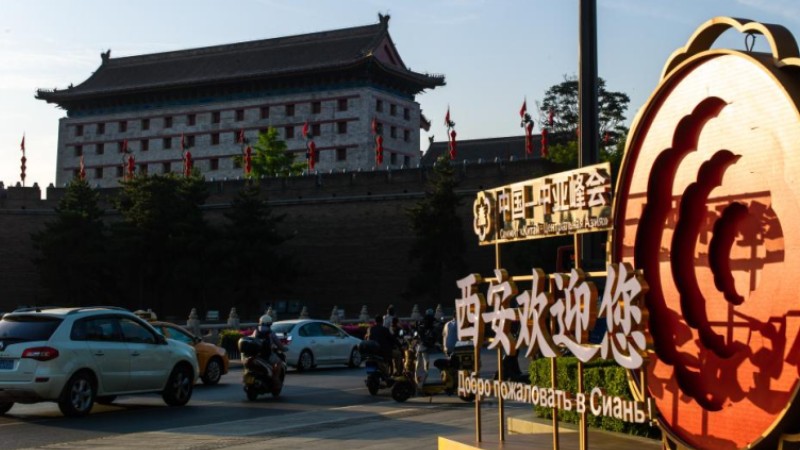China-Central Asia partnership to bear more fruits

SHI YU/CHINA DAILY
Editor's note: The China-Central Asia Summit, to be held on Thursday and Friday, is expected to not only strengthen relations but also boost cooperation and trade between China and the Central Asian states. Six commentators share their views with China Daily on China-Central Asia cooperation.
Cooperation important part of neighborhood diplomacy
In the 31 years since the establishment of diplomatic relations between China and the five Central Asian countries (Kazakhstan, Kyrgyzstan, Tajikistan, Turkmenistan and Uzbekistan) China has adhered to the basic diplomatic principle of good neighborliness and partnership, and considered Central Asia an important part of its neighborhood diplomacy.
These principles have helped strengthen bilateral relations between China and the five Central Asian countries. The relationships have also been strengthened because China and Central Asian countries support each other, and respect each other's sovereignty and territorial integrity, and choice of development path.
"Peace, harmony, cooperation, non-confrontation, and not seeking to establish a sphere of influence" are the basic characteristics of China's diplomacy with Central Asian countries. China and the five Central Asian countries have elevated their relationships from good-neighborly friendship to strategic partnerships, and have become veritable good neighbors, good friends, good partners, and a model for building a new type of international relations in the new era.
In fact, Central Asia became "the first strategic partner cluster around China", making remarkable achievements in various fields. And economic cooperation between China and the five Central Asian countries has become the ballast strengthening bilateral relations. The two sides have also elevated their economic cooperation from mainly bilateral to a combination of bilateral and multilateral relations, with trade in goods and services becoming increasingly diversified, and the cooperation model changing from functional cooperation to institutionalized cooperation. The result is the establishment of a mutually beneficial economic relationship based on mutual respect, mutual benefit and good neighborliness.
We firmly believe the China-Central Asia Summit, to be held on Thursday and Friday, will usher in another golden period for China and Central Asia in the next three decades.
Lu Shanbing, dean of the Central Asia Institute of Northwestern University, Xi'an, Shaanxi province
Kazakhstan welcomes new format of cooperation
Relations between the five Central Asian states and China have reached an important milestone. Just over 30 years ago, the Central Asian countries gained independence and began building a new type of cooperation with their eastern neighbor. Relations between the five Central Asian states and China have reached an important milestone. Just over 30 years ago, the Central Asian countries gained independence and began building a new type of cooperation with their eastern neighbor. In this relatively short period of time, Kazakhstan's relationship with China has reached the high level of permanent comprehensive strategic partnership, characterized by multidimensional interaction in all spheres of activity.
At the turn of the millennium, we began interacting in a multilateral format under the framework of the Shanghai Cooperation Organization, which was formed following the resolution of all border issues among the six countries and the establishment of an atmosphere of trust and good neighborliness.
Exactly 10 years ago, China proposed jointly developing an economic belt along the Silk Road, thereby revitalizing the ancient artery that for centuries had facilitated exchanges between the peoples and civilizations along the route. The Silk Road Economic Belt, which President Xi Jinping proposed in a speech at Nazarbayev University in Astana, Kazakhstan, has evolved into the grandiose Belt and Road Initiative, which today involves more than 150 countries.
The past decade has seen Central Asian countries playing a key role in the development of the initiative. No wonder some of the largest Belt and Road projects have been implemented in Central Asia. New plants, factories, infrastructure facilities and new railway lines have been opened up, and plants generating clean energy have become operational.
Thanks to the joint efforts of all sides, we have managed to contain the COVID-19 pandemic, as proved by lifting of the last quarantine and other restrictions this year. This year has also seen China announcing that it would vigorously promote the Belt and Road Initiative, promote multilateral cooperation, and help strengthen economic globalization. This year will also see China hosting the Third Belt and Road Forum for International Cooperation, where Beijing is likely to announce new plans for advancing the initiative.
There is no doubt that in the next 10 years, the Belt and Road Initiative will reach new heights of development, with Central Asia continuing to play a key role in it. Scientific progress and advanced technologies have helped China and other countries to build the grand Western Europe-Western China Highway and open cross-border railway routes between China and Central Asia countries, which have made transportation more convenient. This in turn has allowed Kazakhstan and other Central Asian countries to once again act as a multifunctional bridge between Europe and Asia.
Turkmenistan, Uzbekistan and Kazakhstan are connected with China through a single gas artery, and a new pipeline being built will connect Kyrgyzstan and Tajikistan with China. Additionally, the promising China-Kyrgyzstan-Uzbekistan railway project is entering a critical stage. This means all the five Central Asian countries have a solid foundation for strengthening mutually beneficial cooperation with China.
In this regard, we have high expectations from the Central Asia-China Summit, which will be held on Thursday and Friday. And there is every reason to believe the summit will open a new page in China-Central Asia relations based on pragmatic economic interests, and mutual understanding and trust. This is important because Central Asia-China cooperation could become a model of mutually beneficial relations amid rising xenophobia, trade protectionism and regional conflicts.
Ruslan Izimov, a researcher of the Center for the Study of Central Asia and China, Kazakhstan
Kyrgyzstan active participant in BRI
China has become one of the main trade and economic partners of Central Asian countries over the past three decades, especially due to the integration of Silk Road Economic Belt projects with the development programs of the five countries in the region in the past decade.
An important reason for this is the Chinese leadership's commitment to deliver on its promises in order to promote the country's peaceful development, which has had a significant impact on building good neighborly relations with Kyrgyzstan and other Central Asian countries. It has also had a positive impact on the conceptual approach to the activities of the Shanghai Cooperation Organization, because jointly promoting peace is an important component of the comprehensive partnership under the SCO framework.
In 2022, marking the 30th anniversary of the establishment of diplomatic relations between China and the five Central Asian countries, President Xi Jinping emphasized that the key to successful cooperation between China and the five states lies in mutual respect, good-neighborliness, solidarity in trying times and mutual benefit.
In particular, China's experience of containing COVID-19 and providing medical assistance to the Central Asian countries helped the latter to implement better prevention and control measures. As for Kyrgyzstan, it received the first batch of testing kits and face masks in March 2020 at a time when they were in short supply throughout the world. After that, China dispatched doctors and other medical workers to Kyrgyzstan who shared their experience with Kyrgyz doctors, helping them to better combat the disease.
China has provided Kyrgyzstan with substantial support over the years for the implementation of major infrastructure projects in the fields of roads, water supply facilities, and housing for public sector workers.
One of the important areas of regional cooperation is the Silk Road Economic Belt, which, in the current global economic situation, can help stabilize the world economy and enhance the investment potential of Central Asia. As one of the most strategic projects of the Silk Road Economic Belt, the China-Kyrgyzstan-Uzbekistan railway, when completed, will improve transportation and boost logistics cooperation among the countries. According to experts, the direct benefits from the railway include improved access to global markets for the Central Asian countries, better trade and economic infrastructure, and increased urbanization.
The railway project includes building bridges, tunnels, stations and logistics centers. Constructing housing, roads, warehouses and gas stations is also part of Belt and Road projects, which will improve urban agglomeration, create clusters of processing enterprises, and increase economic diversification. This in turn will lead to the emergence of hundreds and thousands of trade and service enterprises, creating new jobs and reducing the migration of workers. All this, according to some economists, will lead to an increase in Kyrgyz people's real incomes.
Yet to truly strengthen their economic cooperation, China and the Central Asian countries need to increase investment, and invite experts, the media and the public to objectively assess the results and prospects of interstate cooperation, so as to promote dialogue among the people and experts from all the countries.
Igor Shestakov, a political scientist at Ordo Center, Kyrgyzstan
Belt and Road projects benefit Tajikistan
Chinese President Xi Jinping's proposal of the Silk Road Economic Belt and the 21st Century Maritime Silk Road in 2013 subsequently resulted in a common development policy called the Belt and Road Initiative, which is aimed at improving existing and creating new trade routes, and transport and economic corridors connecting more than 60 countries of Asia, Europe and Africa.
Tajikistan supports the Belt and Road Initiative because, among other things, it will also strengthen mutually beneficial cooperation with China in the fields of trade, investment, transport and communication, and help establish a new, efficient and economically viable interregional transportation system.
The Belt and Road Initiative is a mega project of great historical significance in terms of its prospects for trade and economic cooperation for the benefit of all participating countries and helping improve the well-being of the people.
For Central Asian countries, the implementation of Belt and Road projects will create a good opportunity to deepen regional cooperation, expand the scale of transportation and communication corridors, and promote cultural exchanges. China may have proposed the Belt and Road Initiative, but all the countries involved will benefit from the Belt and Road projects.
The prospects of the revival of the ancient Silk Road were being discussed in the media for a long time, but after Beijing hosted the Belt and Road Forum for International Cooperation in 2017 and in 2019, the whole world turned its eyes to China.
And as expected, the ancient Silk Road has been revived with renewed vigor in the 21st century.
Karieva Farangis Abdurahimovna, a researcher at the National Academy of Sciences of Tajikistan
Uzbekistan's cooperation prospects in BRI are high
Uzbekistan is an active participant in numerous projects under the framework of the Belt and Road Initiative, which helps improve infrastructure connectivity and create economic corridors connecting more countries in Asia, Europe and Africa. The projects will also contribute to the development of Uzbekistan's trade relations with other countries, especially China, which is a major trading partner of more than 140 countries.
The new model of cooperation envisages measures such as political coordination, infrastructure connectivity, trade liberalization, free movement of capital, and strengthening mutual understanding among peoples on the basis of mutual benefit and taking into account the interests of every country.
The unique nature of the Belt and Road Initiative lies in the fact that its projects are open to all countries, and regional and global organizations. It is also the foundation of economic cooperation and the reason for China's leading position in the projects.
Of particular interest to Uzbekistan is the Silk Road Economic Belt, which along with the 21st Century Maritime Silk Road makes up the Belt and Road Initiative, and starting from China, passes through Central Asia and West Asia to Europe (the Baltic Sea) and the Mediterranean.
As for the 21st Century Maritime Silk Road, it starts from China and passes through Southeast Asia, South Asia and the Indian Ocean to the Pacific on the one hand and the Persian Gulf and Africa on the other. Given its expanding range and geography, and since it facilitates the exports of goods, Uzbekistan also has great interest in the 21st Maritime Silk Road.
In the short term, Uzbekistan is interested in accelerating the implementation of the China-Central Asia-West Asia corridor. Belt and Road agreements outline projects in the fields of infrastructure construction, investment in industrial facilities, development of natural resources, trade, financial cooperation, people-to-people exchanges, environmental protection, and maritime cooperation. All of this will attract billions of dollars in investment, help create modern infrastructure, stimulate the training of personnel, and create new jobs, which will serve the interests of Uzbekistan.
As an important factor in expanding cooperation in the region under the Belt and Road framework, Uzbekistan's interactions with other economies on multilateral cooperation mechanisms through the SCO, the Asia Cooperation Dialogue, the Central Asian Regional Economic Cooperation Program and other similar organizations are crucial.
To finance projects, two new financial institutions were established at the initiative of China: the Asian Infrastructure Investment Bank and the Silk Road Fund, which have provided loans for many countries and therefore helped them boost their economic development. For example, Uzbekistan has signed an agreement with the Silk Road Fund to get a loan of $585 million to invest in and develop its oil and gas sector.
The portfolio of the AIIB in Uzbekistan consists of investment projects in the fields of rural infrastructure development, water supply and sanitation, healthcare, road building and reconstruction, and energy development.
We are confident about the successful implementation of all Belt and Road projects, as they are based on equality, and mutual respect and trust.
Shukhrat Isakulov, an advisor to BRI Center in the Uzbek Ministry of Tourism and Cultural Heritage
There is a need to boost Sino-Turkmen friendship
China's unique tradition and its socioeconomic development over the past four decades are nothing less than remarkable. I've wanted to study in China since I learned in high school that China was the historical starting point of the ancient Silk Road in the East.
Turkmen President Serdar Berdymukhamedov has created an opportunity for us to know more about China by introducing Chinese language courses in Turkmenistan's universities. In addition, a lot of young people from our country are pursuing higher studies in China.
Having been studying in China since 2018, I find the Chinese people very kind and helpful. And I will try to introduce new elements of China's history, culture, tradition and governance system to the Chinese courses in Turkmenistan when I return home. That would be my contribution to the strengthening of China-Turkmenistan friendship and the advancement of the Belt and Road Initiative.
Muhammedova Ogulbagt, a student at Northwest University, Xi'an, Shaanxi province
Photos
Related Stories
- Xi welcomes Central Asian countries to board "express train" of China's development
- Deepening China-Central Asia cooperation conforms to prevailing trend of world, people's expectations: Xi
- People in China, Central Asia create glories of ancient Silk Road: Xi
- Officials, experts say deepened China-Central Asia cooperation on Belt and Road benefits region, world
- Art performance held to mark opening of year of culture and art of peoples of China and Central Asia
Copyright © 2023 People's Daily Online. All Rights Reserved.









